Fingerplay: Little Raindrops
This is the sun, high up in the sky. (Form large circle with arms up)
A dark cloud suddenly comes sailing by. (Move hands through the air in a parallel motion.)
These are the raindrops, pitter, pattering down. (Bring arms down, flutter fingers)
Watering the flowers, growing on the ground. (Cup hands to form flowers.)
Activity: Make a book based on this fingerplay. Use the pattern here (Little Raindrops Booklet pattern) to represent the items in the fingerplay. There are four pages for your book (one for each line of the fingerplay). The pattern is a Word document so you can change the size of the objects to save paper, if you wish. The children cut out the pictures. They can cut around them to make it easier. The adults write the words to the fingerplay on each page. For children too young for this craft, the adults make the book FOR their young children. The umbrella can be used on the cover of the book.
Early Literacy Aside--Empower: Making a book with or for your child is very special. By showing care in making them and including your child in the process you make this activity around a book enjoyable. Your child can memorize the words to the rhyme and can "pretend" read it to you. Praise your child. This helps develop print motivation, a child's interest and enjoyment of books and reading. OR Making a book with your child shows them how books work. This helps them with print awareness, how to handle a book, which will get them comfortable with using books as they learn to read. Submitted by Jaime Duval and Whitney Whitaker, Radford (VA) Public Library
 Early Literacy Aside--Example: Print motivation is an interest in and enjoyment of books. Children need this skill prior to formal reading instruction. One way to develop this skill is to use pop-up books and other books that provide surprises. Let's see what surprises this book brings.Read Wide-Mouthed Frog.
Early Literacy Aside--Example: Print motivation is an interest in and enjoyment of books. Children need this skill prior to formal reading instruction. One way to develop this skill is to use pop-up books and other books that provide surprises. Let's see what surprises this book brings.Read Wide-Mouthed Frog.
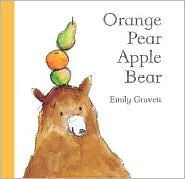 Early Literacy Aside--Example: When you choose books for your children, they like the ones that have pictures of things that are familiar to them. So, here is one with a picture of an apple. You can talk about the apple in the picture, its color, its shape. Then get a real apple and show it to your child. Talk about how it tastes--sweet, how it feels--round and smooth, the sound it makes when you bite it--CRUNCH!By showing your child the real object, you are helping them realize that pictures represent real things. Later they will also understand that printed words represent real things as well. This develops print awareness. I'll read this story to you once, then we'll use the flannel board to tell it again!
Read Orange Pear Apple Bear by Emily Gravett
Early Literacy Aside--Example: When you choose books for your children, they like the ones that have pictures of things that are familiar to them. So, here is one with a picture of an apple. You can talk about the apple in the picture, its color, its shape. Then get a real apple and show it to your child. Talk about how it tastes--sweet, how it feels--round and smooth, the sound it makes when you bite it--CRUNCH!By showing your child the real object, you are helping them realize that pictures represent real things. Later they will also understand that printed words represent real things as well. This develops print awareness. I'll read this story to you once, then we'll use the flannel board to tell it again!
Read Orange Pear Apple Bear by Emily Gravett
 Book Introduction: Our next story is Mouse Mess by Linnea Riley. Notice the words on boxes and bottles as Mouse finds food to eat.
Read the book, saying the words on the boxes and bottles as you point to them.
Early Literacy Aside--Example: Pointing out the words we see on boxes and bottles is one way to help children develop one of the early literacy skills, print awareness, understanding that print has meaning.
Activity: At the end of storytime put out cereal boxes, bottles, any containers with writing on it and let the children "read" them.
Early Literacy Aside--Empower: Don't forget, when you go shopping or are just out and about, talk with your children about the signs and labels they see, just as we did with Mouse Mess. This is one simple way to develop your children's print awareness.
Book Introduction: Our next story is Mouse Mess by Linnea Riley. Notice the words on boxes and bottles as Mouse finds food to eat.
Read the book, saying the words on the boxes and bottles as you point to them.
Early Literacy Aside--Example: Pointing out the words we see on boxes and bottles is one way to help children develop one of the early literacy skills, print awareness, understanding that print has meaning.
Activity: At the end of storytime put out cereal boxes, bottles, any containers with writing on it and let the children "read" them.
Early Literacy Aside--Empower: Don't forget, when you go shopping or are just out and about, talk with your children about the signs and labels they see, just as we did with Mouse Mess. This is one simple way to develop your children's print awareness. Talk about spiders and how they spin their webs. Each web is different. They use their webs to catch their food.Read the book The Very Busy Spider by Eric Carle.
Put up pieces on a flannel board, having the participants retell the story as you put up the pieces.
Early Literacy Aside--Example: This book has lots of repetition so it is a good one for retelling. I have a handout with the same figures that I used on the flannel board. I will also pass out some yarn to make the web. You can cut out the figures and use the yarn to retell the story. Helping your children to retell stories will help them understand what they read later in school.
Talk about spiders and how they spin their webs. Each web is different. They use their webs to catch their food.Read the book The Very Busy Spider by Eric Carle.
Put up pieces on a flannel board, having the participants retell the story as you put up the pieces.
Early Literacy Aside--Example: This book has lots of repetition so it is a good one for retelling. I have a handout with the same figures that I used on the flannel board. I will also pass out some yarn to make the web. You can cut out the figures and use the yarn to retell the story. Helping your children to retell stories will help them understand what they read later in school. Book Introduction: In our next book, there is a mother hen and her three chicks, one is a Big Chick, one the Middle Chick, and lastly the Little Chick. The Little Chick likes to run on tiptoes, very quickly. Everyone stand up. Let me see you run in place, just where you are standing. Great! Now let me see you stand on tiptoe. That's right you don't touchyour heel to the floor. Now run in place again, but on tiptoe--that's how Little Chick runs. Everyone sit down and let's see what happens. In this book there are sounds like RUFF-RUFF that the dog makes. Let me hear you say that. Great! For Little Chick the sound is tippy-toe, tippy-toe, tippy-toe. Let me hear you say that. Great!OK, ready?! As I read the book you'll be making these sounds. Listen to the story too and see how smart Little Chick is.
Read the story Tippie-Toe Chick, Go! by George Shannon.
Early Literacy Aside--Example: Having your children make the sounds of animals and other sounds helps them develop phonological awareness, being able to hear the smaller sounds in words. This is so important when they later try to sound out words.
Book Introduction: In our next book, there is a mother hen and her three chicks, one is a Big Chick, one the Middle Chick, and lastly the Little Chick. The Little Chick likes to run on tiptoes, very quickly. Everyone stand up. Let me see you run in place, just where you are standing. Great! Now let me see you stand on tiptoe. That's right you don't touchyour heel to the floor. Now run in place again, but on tiptoe--that's how Little Chick runs. Everyone sit down and let's see what happens. In this book there are sounds like RUFF-RUFF that the dog makes. Let me hear you say that. Great! For Little Chick the sound is tippy-toe, tippy-toe, tippy-toe. Let me hear you say that. Great!OK, ready?! As I read the book you'll be making these sounds. Listen to the story too and see how smart Little Chick is.
Read the story Tippie-Toe Chick, Go! by George Shannon.
Early Literacy Aside--Example: Having your children make the sounds of animals and other sounds helps them develop phonological awareness, being able to hear the smaller sounds in words. This is so important when they later try to sound out words. Book Introduction: Our next book is Don't Worry Bear by Greg Foley. [Run your finger under the title.] In this book the caterpillar says the words "Don't worry, bear" over and over again. Let's practice saying that--"Don't worry. bear." Good! . . .As I read the book, I'll point to you all and you'll know to say, "Don't worry, bear." [As you read the book run your finger under the words don't worry bear, as they say these words.]
Early Literacy Aside--Example: You noticed that I ran my finger under the words don't worry bear each time you all said those words. This helps develop your children's print awareness, knowing that print has meaning and that it is the words we read. You can do this with any book you read!
Book Introduction: Our next book is Don't Worry Bear by Greg Foley. [Run your finger under the title.] In this book the caterpillar says the words "Don't worry, bear" over and over again. Let's practice saying that--"Don't worry. bear." Good! . . .As I read the book, I'll point to you all and you'll know to say, "Don't worry, bear." [As you read the book run your finger under the words don't worry bear, as they say these words.]
Early Literacy Aside--Example: You noticed that I ran my finger under the words don't worry bear each time you all said those words. This helps develop your children's print awareness, knowing that print has meaning and that it is the words we read. You can do this with any book you read!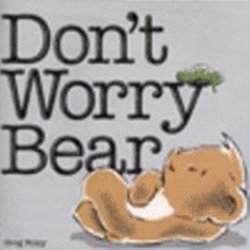
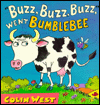 Early Literacy Aside--Explain: Narrative skills can be developed by having your children tell stories. This is easier for some children when they recognize patterns so that they can predict what will happen next.Early Literacy Aside--Example: As we read the book we want to encourage our children to recognize the pattern and to repeat "buzz, buzz, buzz" and "buzz off."
Read Buzz, Buzz, Buzz! Went Bumble-bee by Colin West
Fingerplay: Here is the Beehive
Here is the beehive. Where are the bees? (Hold up fist.)
Hidden away where nobody sees. (Move other hand around fist.)
Watch and you see them come out of the hive. (Bend head close to fist.)
One, two, three, four, five. (Hold fingers up one at a time.)
Bzzzzzzzz all fly away! (Wave fingers.)
Early Literacy Aside--Empower: Children enjoy repeating phrases as they did in our book and song. Please help your children look for patterns in the books and songs you do at home. This helps foster your children's narrative skills which will later help them understand how stories work and will help them understand what they read.
Early Literacy Aside--Explain: Narrative skills can be developed by having your children tell stories. This is easier for some children when they recognize patterns so that they can predict what will happen next.Early Literacy Aside--Example: As we read the book we want to encourage our children to recognize the pattern and to repeat "buzz, buzz, buzz" and "buzz off."
Read Buzz, Buzz, Buzz! Went Bumble-bee by Colin West
Fingerplay: Here is the Beehive
Here is the beehive. Where are the bees? (Hold up fist.)
Hidden away where nobody sees. (Move other hand around fist.)
Watch and you see them come out of the hive. (Bend head close to fist.)
One, two, three, four, five. (Hold fingers up one at a time.)
Bzzzzzzzz all fly away! (Wave fingers.)
Early Literacy Aside--Empower: Children enjoy repeating phrases as they did in our book and song. Please help your children look for patterns in the books and songs you do at home. This helps foster your children's narrative skills which will later help them understand how stories work and will help them understand what they read. Early Literacy Aside--Explain: Rhyming is one way that children learn to hear that words are made up of smaller parts. By doing rhymes with them you are supporting phonological awareness. This skill helps them when they later try to sound out words. And it's fun, too!Read Who's There on Halloween? by Pamela Beall
Early Literacy Aside--Explain: Rhyming is one way that children learn to hear that words are made up of smaller parts. By doing rhymes with them you are supporting phonological awareness. This skill helps them when they later try to sound out words. And it's fun, too!Read Who's There on Halloween? by Pamela Beall
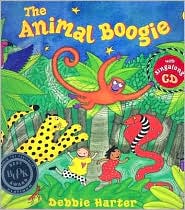 Early Literacy Aside--Explain: Researchers have found that one of the early literacy skills is phonological awareness. This is the ability to hear and play with the smaller sounds in words, like rhyming and hearing the beginning sounds of words. Today I'll be pointing out ways you can help your children with this skill.Early Literacy Aside--Example: Our next book is one we can sing. Listen to all the rhymes in this book. Singing slows down language and rhyming breaks down words into parts. Both of these help your children hear the smaller sounds in words. You can also think of other words that rhyme, or add extra verses at the end.
Read the book Animal Boogie by Debbie Harter.
Early Literacy Aside--Explain: Researchers have found that one of the early literacy skills is phonological awareness. This is the ability to hear and play with the smaller sounds in words, like rhyming and hearing the beginning sounds of words. Today I'll be pointing out ways you can help your children with this skill.Early Literacy Aside--Example: Our next book is one we can sing. Listen to all the rhymes in this book. Singing slows down language and rhyming breaks down words into parts. Both of these help your children hear the smaller sounds in words. You can also think of other words that rhyme, or add extra verses at the end.
Read the book Animal Boogie by Debbie Harter.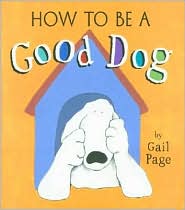 Early Literacy Aside--Explain: Narrative skills is the ability to describe things and to talk about events, and to tell stories. Researchers have noted this skill as one of the early literacy skills that will help your child be ready to read. It helps them understand what they will read.Our next book is How To Be a Good Dog by Gail Page. Let's see what this dog learns.
Read How to Be A Good Dog.
Early Literacy Aside--Example: Acting out stories with your whole body helps our children remember the story to retell it. Let's act out the story together now.
Early Literacy Aside--Empower: Developing narrative skills is as easy as talking with your child about what you've read AND especially having them respond too. You can ask them, "What was the funniest part for you?"
Early Literacy Aside--Explain: Narrative skills is the ability to describe things and to talk about events, and to tell stories. Researchers have noted this skill as one of the early literacy skills that will help your child be ready to read. It helps them understand what they will read.Our next book is How To Be a Good Dog by Gail Page. Let's see what this dog learns.
Read How to Be A Good Dog.
Early Literacy Aside--Example: Acting out stories with your whole body helps our children remember the story to retell it. Let's act out the story together now.
Early Literacy Aside--Empower: Developing narrative skills is as easy as talking with your child about what you've read AND especially having them respond too. You can ask them, "What was the funniest part for you?" Early Literacy Aside--Explain: Today I'll be pointing out some activities we are doing that support ealry literacy in the area of vocabulary. This is the term that researchers give to knowing the meanings of words. You can see what we do here in storytime and you may get some ideas of what you can do with your children throughout the day.Read the book Who Is Driving? by Leo Timmers. Pause occasionally to talk about a picture and ask what they see in the picture. Add a word or two, synonyms to the words in the the book, the children might not know.
Early Literacy Aside--Example: As you can see, I don't just read the book. We talk about the pictures and ask questions. Allow time for your child to say something back, even if you don't understant exactly what they say. You can see I added in a couple of unfamiliar words too.
Early Literacy Aside--Empower: Our youngest children learn words that name things they can see (pig, tractor, hippopotamus). As children get older they understand words for feelings and concepts, and older still, they understand words for ideas. It is good to expose even young children to all kinds of words, but they will understand the words for things they can see first.
Early Literacy Aside--Explain: Today I'll be pointing out some activities we are doing that support ealry literacy in the area of vocabulary. This is the term that researchers give to knowing the meanings of words. You can see what we do here in storytime and you may get some ideas of what you can do with your children throughout the day.Read the book Who Is Driving? by Leo Timmers. Pause occasionally to talk about a picture and ask what they see in the picture. Add a word or two, synonyms to the words in the the book, the children might not know.
Early Literacy Aside--Example: As you can see, I don't just read the book. We talk about the pictures and ask questions. Allow time for your child to say something back, even if you don't understant exactly what they say. You can see I added in a couple of unfamiliar words too.
Early Literacy Aside--Empower: Our youngest children learn words that name things they can see (pig, tractor, hippopotamus). As children get older they understand words for feelings and concepts, and older still, they understand words for ideas. It is good to expose even young children to all kinds of words, but they will understand the words for things they can see first.
 Aside: As your baby begins to talk, respond by elaborating on what he says. For example, if your baby points to a picture and says "cat" respond by saying, "Yes, that's a little cat with orange fur." Talking about the picture even if your baby doesn't understand everything also helps build your child's vocabulary. For example, you could say, "Look, the two kittens are playing with the string. They are having fun together."Submitted by Cindy Christin, Bozeman (MT) Public Library
Aside: As your baby begins to talk, respond by elaborating on what he says. For example, if your baby points to a picture and says "cat" respond by saying, "Yes, that's a little cat with orange fur." Talking about the picture even if your baby doesn't understand everything also helps build your child's vocabulary. For example, you could say, "Look, the two kittens are playing with the string. They are having fun together."Submitted by Cindy Christin, Bozeman (MT) Public Library